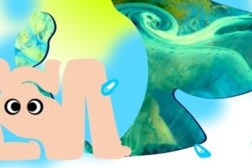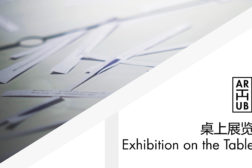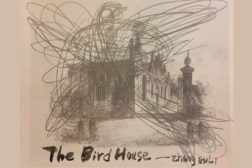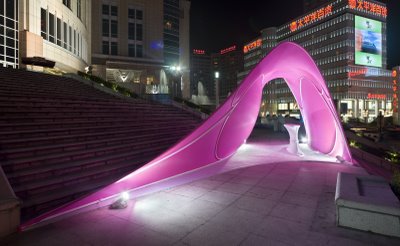
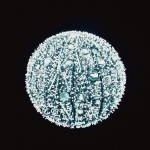
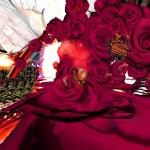



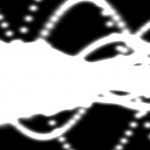
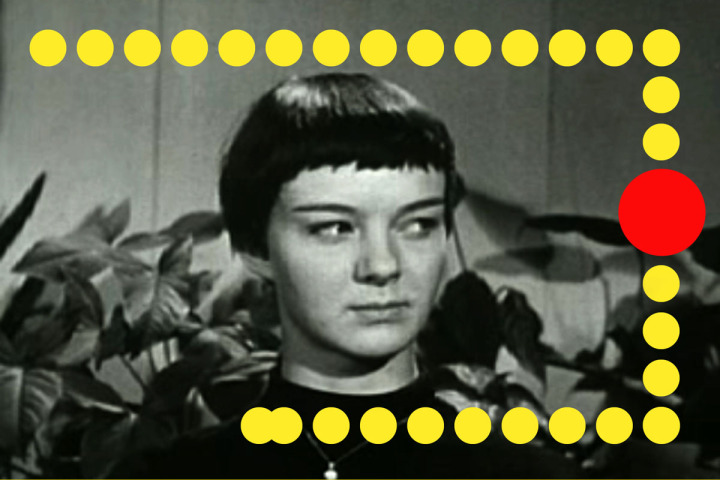
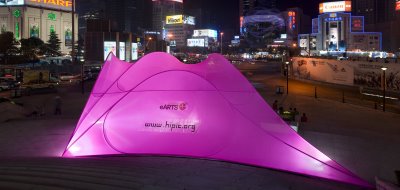
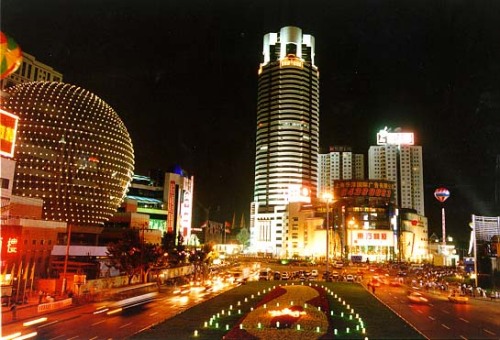
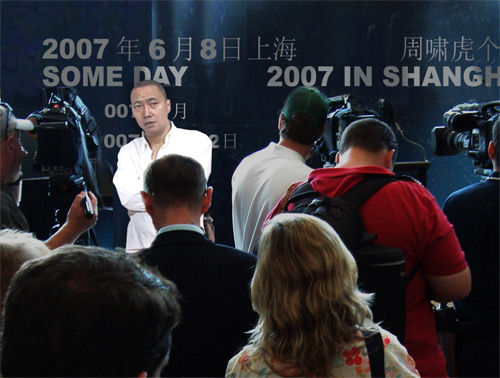
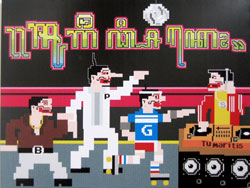
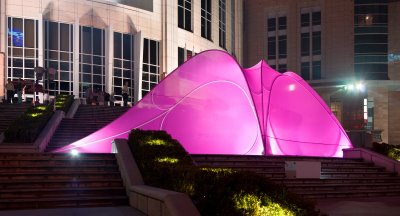

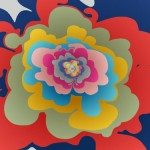
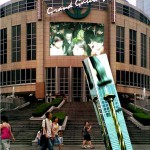

Final Cut-Processing New Media in Public Space
Arthub is delighted to present Final Cut-Processing New Media in Public Space, a five-day programme of live performances, site-specific installations and video screenings in Xuhui District, a flourishing and bustling area of Shanghai. Presented as part of the Shanghai eArts Festival 2008 with a special focus on the livability of urban space, public sphere, and its transformation through new media, Final Cut has been developed in co-operation with visual artists, musicians, DJs, architects, programmers, dancers, and designers.
Featured artists and presenters include: Christian Marclay, Elliott Sharp, Wu Na, Bruce Gremo, Wang Li Chuan, Ben Houge, Yan Jun, Top Floor Circus, Aaajiao, Nunu, Ling Xi, B6, Alizia Borsari, Deadj + Chen Xiongwei, Feng Mengbo, Wang Yuyang, Zhou Xiaohu, Michael Bell Smith, Shih Chieh Huang, Terra Bajraghosa, Takeshi Murata, and Eric Siu. On view will also be Hipic.org and 40+4, Art is Not Enough! Not Enough!
Final Cut is organized by Davide Quadrio and Defne Ayas.
Final Cut Program:
Installations by Wang Yuyang and Zhou Xiaohu.
Videos by Michael Bell Smith, Shih Chieh Huang, Terra Bajraghosa, Takeshi Murata, and Eric Siu. Plus 40+4 and Hipic.org.
Stage Program (at Hengshan Road and Wanping Road):
October 18th at 7:30 pm, 40+4, Art is Not Enough! Not Enough!, screening
October 19th at 7:30 pm, Patience for the Man by Aajiao with Nunu, Ling Xi, B6 and Alizia Borsari, live performance
October 20th at 7:30 pm, Deadj + Chen Xiongwei, live performance
October 21st at 7:30 pm, Q2008 by Feng Mengbo, live interactive performance
October 22nd at 7:30 pm, Screen Play by Christian Marclay, live performance
Project Descriptions
40+4, Art is Not Enough! Not Enough!
Davide Quadrio embarked on an interview project presenting a cross section of the art scene in Shanghai with artists from all streams of art-making: the avant-garde, the traditional, official or academic scene. Together with Lothar Spree, Zhu Xiaowen, and Xu Jie (the last of whom in the role of professional interviewer) 40+4, Art is Not Enough! Not Enough!, probed the relationship between the artists, their work, and the evolution of contemporary art in Shanghai over the last two decades. The presentation of this project for eArt represents an open dialogue of the artistic community to the city, a vis a vis discourse that will bring reflections, happiness and frustration, critical analyses of the cultural development of the city in the last 15 years.
Patience for the Man
Patience for the Man is born following a number of workshops to explore the possibility of an open creative interdisciplinary production, where the “actors” could, through the work in progress, come to know each other better, thus generating new artistic content, meaning and directions. Select visual artists were asked to go beyond their medium and to experience new techniques of expressions more affiliated with decontextualized emotions. The result is a multi-media presentation, a live performance within a musicscape. Both B6 and Aaajiao perform live together alongside stage dancers created by the architect duo Wang Zhenfei and Wang Luming. They consider the presentation a work in progress, it is a temporary result that will be further developed in future presentations.
Deadj + Chen Xiongwei
Exploring once again the DJ status as a performance “in travesty,” Deadj presents his music on a multi-layered video screening created by Chen Xiongwei, combining sounds and images both performed live. The minimalist music created by Deadj will be accompanied by Chen’s digitalized and psychedelic images of public spaces in Shanghai.
Q2008
Beijing-based new media pioneer Feng Mengbo offers audiences a participatory journey in Q2008, through virtual imagery, metaphorically linking game surfing, and painting-making process. The work allows viewers (public audience, artist, player, curator) to assume several of these roles during the course of his presentation, which implies a reconfiguration of the audiences into a cinematic experience as well as into a process of art-making. The time-based nature of his game software shifts itself out of its usual context, and as it comes off of the screen, allows the game character to interact dynamically without a proscribed outcome.
Screen Play
Christian Marclay’s video score in which found film footage is combined with computer animation to create a visual projection to be interpreted by musicians. Using video projection to convey instructions to musicians, he composed a silent collage of found film footage partially layered with computer graphics to provide a framework in which live music can develop. Screen Play will be interpreted by three different ensembles comprised of Chinese and international musicians. Marclay’s long-time collaborator Elliott Sharp will join him from the avant-garde experimental music scene in New York City, to play with the award-winning guqin player Wu Na, and Chinese opera percussionist Wang Li Chuan, both from Beijing. Shanghai-based composer and videogame audio guru Ben Houge will explore the various layers of information present in the video, together with Yan Jun, a found-sound spinner and master of ambient soundscapes, and Bruce Gremo, a veteran improviser performing on his custom-made electronic flute controller, the Cilia. The opening act will be performed by Top Floor Circus, a Shanghai-based folk-cum-art-cum-punk band.
Track One: Installations
Zhou Xiaohu, The Golden Needle
“Art can never be made by machine alone,” Zhou Xiaohu says when creating his sculptural installations that involve animation, as well as analogue elements. In his newly commissioned production for the public in the heart of Xujiahui (Ganghui), Zhou Xiaohu creates a monumental installation. The Golden Needle is a column, consisting of four LED screens; the needle appears as if it’s being hammered into the floor. The installation is designed to signify the heart of our post modernist society’s consumerist lifestyle. It also acts as a sign to remind the public of the ephemeral value of this hyper commercial lifestyle.
Wang Yuyang, Artificial Moon
The second large-scale installation for Xujiahui is created by the Beijing based artist Wang Yuyang. Suspended in-between trees in the only “natural habitat” of the Xujiahui area, namely the Xuhui park, this particular abstraction of the rarely seen moon in Shanghai skies induces a kind of artificial sense of nature and provides a surprising experience for its audiences.
First created ad hoc few years ago on an industrial complex that has now completely disappeared, this installation will create a shifting presence of the artificial light of the Xujiahui commercial center into the park, playing with the contradiction of artificial and natural, of real and surreal for the ultimate esthetic pleasure of the public.
Artificial Moon has departed from the clichéd Chinese symbolism. “Here the form of the moon has been re-contextualized, and is placed within touching distance where all possible metaphors are blended into pulsing light,” writes curator Li Zhenhua of the work. Wang Yuyang adds: “Looking at the artificial moon, we are watching the lights illuminating themselves.”
Track Two: Video Screenings
Artistic content must take the wavelengths as much as advertising content. Xuhui District is the busiest section of Shanghai, a flourishing and bustling commercial area with youth hanging out at shopping centers, movie theatres on the weekend, also a residential area with high-rises, well-known high end shopping malls as well as universities such as Shanghai Jiaotong University, Fudan University (Fenglin Campus), Shanghai Normal University, Shanghai Conservatory of Music, all in the vicinity. The area we are looking at gives us a special focus on the livability of urban space, public sphere and its transformation through new media. The select video program will network the LED infrastructure of Xujiahui to create a direct engagement with its public, while allowing us to explore the limits of how the currently highly commercial use of outdoor screens can be broadened with cultural content and issues.
Full LED Screen Schedule
October 18th
LED Grand Gateway
7:30 to 8:30 Hipic.org
8:30 – 10:30 40+4, Art is Not Enough! Not Enough!, video screening
LED Oriental Department store
7:30 to 8:30 Michael bell Smith
8:30 to 10:30 40+4, Art is Not Enough! Not Enough!, video screening
LED Pacific Department Store
7:30 to 8:30 eArts video screening
8:30 to 10:30 40+4, Art is Not Enough! Not Enough!, video screening
LED Globe Metro City
7:30 to 8:30 eArts Logo
8:30 t0 10:30 40+4, Art is Not Enough! Not Enough!, video screening
October 19th
LED Grand Gateway
7:30 to 8:30 Hipic.org
8:30 t0 9:30 Eric Siu and Shih Chieh Huang
LED Pacific Department Store
7:30 to 8:30 40+4, Art is Not Enough! Not Enough!, video screening
8:30 t0 9:30 40+4, Art is Not Enough! Not Enough!, video screening
LED Globe Metro City
7:30 to 8:30 Takeshi Murata
8:30 t0 9:30 Takeshi Murata
October 20th
LED Grand Gateway
7:30 to 8:30 Hipic.org
8:30 t0 9:30 Tera Brajaghosa
LED Pacific Department Store
7:30 to 8:30 Takeshi Murata
8:30 t0 9:30 Takeshi Murata
LED Globe Metro City
7:30 to 8:30 Aaajiao
8:30 t0 9:30 Aaajiao
October 21st
LED Grand Gateway
7:30 to 8:30 Hipic.org
8:30 t0 9:30 Takeshi Murata
LED Pacific Department Store
7:30 to 8:30 Eric Siu
8:30 t0 9:30 Eric Siu
LED Globe Metro City
7:30 to 8:30 Aaajiao
8:30 t0 9:30 Aaajiao
October 22nd
LED Grand Gateway
7:30 to 8:30 Hipic.org
8:30 t0 9:30 Eric Siu and Shih Chieh Huang
LED Pacific Department Store
7:30 to 8:30 Takeshi Murata
8:30 t0 9:30 Takeshi Murata
LED Globe Metro City
7:30 to 8:30 Tera Brajaghosa
8:30 t0 9:30 Tera Brajaghosa
A Documentary by Arthub’s Director Davide Quadrio
40+4, Art is Not Enough! Not Enough!
What is the current situation of Shanghai artistic development? What are the positions of artists within that development? How do artists perceive themselves in this fast changing context and art economy? We put together a series of questions, personal, public, irreverent and naïve, to understand what is going on in the mind of the artists, who are the pillars of the contemporary art scene in Shanghai, especially in the wake of an alienating globalization and commercialization.
After 10 years involved in Shanghai art, Davide Quadrio embarked on an interview project, with artists from all areas of art-making, not only the avant-garde, but also the traditional, official or academic scene. He hoped to present a cross section of art in Shanghai. A number of the selected artists are museum directors, while others are teachers. This project adopted a sort of sociological approach; we undertook research to discover whether this uneasiness was deep-rooted in or shared by Shanghai artists.
And so, together with Lothar Spree, Zhu Xiaowen, and Xu Jie–the last of whom undertook the role of professional interviewer–40+4, Art is Not Enough! Not Enough! probed the relationship between the artists, their work, and the evolution of contemporary art in Shanghai over the last two decades. Forty artists and the four people mentioned above got involved in the research project, for a total of forty-four, the number which, in Chinese, sounds like the translation of “double death,” which is reminiscent of a common tongue twister in the language. Indeed, all the connotations of the number forty-four seemed to us to be ironically appropriate for defining the heart and soul of our project.
The 40 artists interviewed were asked the same questions, each of which was printed on a flashcard; there were twenty-seven cards in all, divided into four colors, along with a set bearing famous quotations about art made by historical figures. The interview got underway with four general and autobiographical questions about the artist (grey cards), and moved on to questions that were philosophical or psychological (blue cards), followed by questions that were of a political or sociological nature (green cards), and winding up with questions about art as a product (red cards). The conversation ended with the artist choosing one last card from the pack containing dozens of quotations (light green cards) by various personalities, concerning the meaning of art. The artist was asked to comment on the card he or she had drawn out loud, and propose a personalized version of the quote if he or she so desired. The interview/conversation lasted on average 30 to 45 minutes, and occasionally an hour.
A painstaking editing process resulted in a composition in which the images flickered across the screen at a hypnotic pace, this perfectly reflects the view of the contemporary art and culture scene in Shanghai: its fragmentation and continuous evolution. By way of this “forced” conversation, the artists’ narratives attempt an analysis of the history of contemporary art from the 1980’s to the present, as they reflect on the condition of the urban artist, the ties existing between contemporary Chinese art and its past, as well as in relation to the world history of art. Artists are also asked to review the art market and the state of artistic criticism in China. The presentation was designed to unfold on four screens, in doing so the film’s narrative not only presents the individual artists, but also the collective point of view of the forty subjects interviewed: a vision of artistic Shanghai that isn’t me, myself, and I.
The presentation of this project for eArt represents an open dialogue of the artistic community to the city, a vis-a-vis discourse that will bring reflections, happiness and frustration; this critical analyses of the cultural development of the city will address the last 15 years in Shanghai. For this occasion, 40+4 Art is Not Enough! Not Enough! is shown in two different formats: the 4 screens will be displayed in the Xujiahui Park, while a new edited version created ad hoc for the festival is presented on the LED screens on the commercial buildings that surround Xujiahui Square.
Artists Interviewed: Shen Fan, Zhang Enli, Shi Yong, Yu Youhan, Zhou Tiehai, Huang Yuanqing, Xu Zhen, Huang Kui, Yang Fudong, Lu Chunsheng, Liang Yue, Liu Jianhua, Li Shan, Zhang Ding, Tang Maohong, Wang Xingwei, Song Tao, Lao Jin Feng, Hu Jieming, Xiang Liqing, Yang Zhenzhong, Ding Yi, Luo Yongjin, Qiu Anxiong, Xu Longbao, Wang Tiande, Zhu Julan, Song Haidong, Gu Wenda, Li Xiangyang, Gong Yan, Li Lei, Liu Dahong, Wang Nanming, Yu Xiaofu, Zhang Peicheng, Xia Haicun, Qiu Dexiu, Yang Hui
Further Information on Final Cut Video Screenings:
Inspired by early 20th century Futurist notions of dynamism, speed, industrial noise, and metropolitan cities, video works will be presented by cross-generational Chinese and international artists on LED screens in Xujiahui. Forms, light, and colors, abstract compositions, implied movement, beauty of speed, and the overflow of reality will be explored by Aaajiao (Xu Wenkai), Terra Bajraghosa, Michael Bell-Smith, Shih Chieh Huang, Takeshi Murata and Eric Siu.
Aaajiao (Xu Wenkai)’s video work is inspired by generative processes and code as its main source material. Examining these as cultural forms rather than mere sets of command sequences, Aaajiao investigates the mechanisms of control and cryptic systems that underlie software by destabilizing computing through its varied open source tools.
Terra Bajraghosa has been widely influenced by pop-culture. In his witty animation works, Bajraghosa uses the nostalgic aesthetics of period animation and mass-communication channels to comment on the current political and social climate in Indonesia, especially Java. His work is fresh and easily accessible to public, but also deeply critical and ironical of status quo.
Michael Bell-Smith also uses digital forms to explore popular culture and how it is mediated through popular technologies. Remixing and reinterpreting sources ranging from music videos to classic cinema and contemporary art, Bell-Smith questions the cultural meaning of these materials. On The Grid incorporates the visual vocabulary of the Internet, specifically of an animated gif, referencing the aesthetics and semiotics of Web sites. It is a video that consists of a succession of structures at night, appearing to be high-rise buildings, defined only by lights moving by in parallax, as if viewed from a speeding train, such as Shanghai’s Maglev.
Employing an artistic language that explores the affinities among technology, nature, and every day life, Shih Chieh Huang is usually known for his flamboyant installations that glue found artificial, plastic materials and dissected electronics together to create interactive organic living environments and sculptures. For eArts festival, he presents a low-fi video that produces a curious dialogue between the people of Xuhui and Shanghai’s city landscape at night. Seemingly devoid of life at first, once set into motion, the video is from the vantage point of a blinking eye, that begins to wander around, ultimately taking over the cityscape. Eventually it sets out to have its own organic life and begins to reproduce itself among the crowds. Nurturing a simultaneously familiar and strange interaction between urban environment, technology, and individual existence, the work succeeds in acting as a spatial manipulator showing “how to” alter urban screens into art. When the vision reveals only one eye contemplating what it all means, it makes us all believe that the quest for presence is after all possible in a single look.
Takeshi Murata, on the other hand, pushes the boundaries of digitally manipulated psychedelia. He produces abstract digital works that refigure the experience of animation. Creating Rorschach-like fields of seething color, form and motion, Murata’s synaesthetic experiments in hypnotic perception appear at once seductively organic and totally digital.
Based in Hong Kong, the inventive new media artist Eric Siu has a broad interest in animation, video, installation and interactivity. Actor Jackie Chan and video game Super Mario Brothers come together in Siu’s video entitled Super Cop World, which takes the viewer through a virtual “session” of playing the original video game, with Mario cleverly replaced by a clip of Jackie Chan. When Mario jumps, it is a tiny square screen of Jackie jumping from a building onto a truck that is super-imposed; when Mario swims, there is Jackie diving down into shark-infested waters.
Hipic.org is an image for all time: an online project as a place of the ephemeral, where in one minute a photo sums up the need for a vision, before disappearing into a cybernetic void–forever. This digital project is art without an artist, art without economic value, art that disappears and re-appears, in the quest for attention and observation, knowing that this is the sole possibility in the world, and at the same time the only simultaneous moment in the world.
Hipic.org is a democratic archive location with no hope for the future. It is very fitting in reference to China today, with specific allusion to Shanghai. There is a resounding idea of the continuous moving towards something else, with no past and possibly no idea of the future either–this impertinent, optimistic and flattering present that leaves no time other than for a cursory glance at reality, like so many others, it is in fact completely useless.
Track Three: Performances
Despite the relatively humble size of the Xuhui park and its limited space for public use, a stage has been created for evenings of performances, with the goal of creating a more lively, real-time thinking environment, with an integrated cross-disciplinary focus, where artists collaborate with musicians, DJ’s, architects, choreographers, and programmers.
Following a number of workshops Patience for the Man (a work in progress) explores the possibility of an open, creative, interdisciplinary production, where the single “actors” could come to know each other and generate new artistic content, meaning and directions.
Alizia Borsari introduced a new dramaturgy to the dancers. Select visual artists were asked to go beyond their medium and to experience new techniques of expressions more affiliated to decontextualized emotions. The result is a multi-media presentation, a live performance within a musicscape. Both B6 and Aaajiao perform live together with the dancers on a stage created by the architect duo Wang Zhenfei and Wang Luming. The presentation is still a work in progress–a temporary result that will be further developed in future presentations.
This collaborative way of working in a multi-disciplinary context is fairly new in China. Only a few experiences like this one where usefully put in place in the last decade.
As Els Silvrants of Theatre in Motion writes: “In this respect this program, will create a localized partnership with artists from various disciplines that traditionally are not communicating enough at a creative level. The projects presented are interested in creating, through a work in progress, connections and clusters in China that are able to go beyond themselves to the public in other places. […] Working with the right partners, in a collaborative effort, establishing in effect a network based on artistic integrity, quality standards and an equal sense of professionalism. It also provides artists, curators and the audience in China and Europe with an important point of reference. It allows for a “context” to grow in China while events and exhibitions in Europe on China can draw upon a solid knowledge framework rooted in the local scene, providing a more in-depth image of the China situation, than we unfortunately often come across in big China festivals and exhibits in Europe.”
Participants:
B6, music composer; Alizia Borsari, art director and performer, Beijing; Aaajiao, new media artist and computer programming, Shanghai; Nunu, dancer, Shanghai; Ling Xi, Ddncer, Shanghai; Wang Zhenfei and Wang Luming, architect and concept designer, the Netherlands; He Yiming, graphic designer, Shanghai
Feng Mengbo, October 21st at 7:30pm
Based in Beijing, Feng Mengbo has been working on the blurred boundary between digital gaming and contemporary art by showcasing works that inhabit both spheres. Besides experimental modifications of commercial games and the creation of his own games, he has extensively used game hardware and software for social commentary, as well as in the development of performance projects, and even painting.
For Shanghai city, he offers audiences a participatory journey in Q2008, through virtual imagery, metaphorically linking game surfing, and painting-making process. The work allows viewers (public audiences, artists, players and curators) to assume several of these roles during the course of his presentation, which implies a reconfiguration of the audiences into a cinematic experience, as well as into a process of art-making. The time-based nature of his game software shifts itself out of its usual context, and as it comes off of the screen, allows the game character to interact dynamically without a proscribed outcome.
Christian Marclay, October 22nd at 7:30pm
As an artist and member of the avant-garde music scene, Marclay has continuously explored the process of seeing and hearing music. His innovative use of visual and audible materials has resulted in a body of work that is challenging, compelling, witty and often highly serious. As a musician and DJ, Marclay began to incorporate scratched, broken, and otherwise altered records into his performances in the early 1980’s.
Marclay has also used varying forms of media to create a variety of sculptures during the past 20 years, often incorporating familiar objects such as stereo speakers, telephone receivers and magnetic tape.
Motivated by his desire to not only present music or sound in a physical form, but to explore their deeper social meanings, Marclay has recently begun to further explore previous creative principles and themes in new works using videos such as Screenplay, which he presented for the first time in New York as part of PERFORMA 05, the first visual art performance biennial of the city.
Screenplay is a video score in which found film footage is combined with computer animation to create a visual projection to be interpreted by musicians. Using video projection to convey instructions to musicians, “I composed a silent collage of found film footage partially layered with computer graphics to provide a framework in which live music can develop. Moving images and graphics give musicians visual cues suggesting emotion, energy, rhythm, pitch, volume, and duration. I believe in the power of images to evoke sound,” says Christian Marclay of his work.
Screenplay will be interpreted by three different ensembles comprised of Chinese and international musicians. Marclay’s long-time collaborator Elliott Sharp will join him from the avant-garde experimental music scene in New York City, to play with the award-winning guqin player Wu Na, and Chinese opera percussionist Wang Li Chuan, both from Beijing. Shanghai-based composer and videogame audio guru Ben Houge will explore the various layers of information present in the video, together with Yan Jun, a found-sound spinner and master of ambient soundscapes, and Bruce Gremo, a veteran improviser performing on his custom-made electronic flute controller, the Cilia. The opening act will be performed by Top Floor Circus, a Shanghai-based folk-cum-art-cum-punk band. The band plans to explore the emotional subtexts of the score by sampling from their repertory.
When presented for the first time in New York, Roberta Smith, of The New York Times, commented on Screenplay: “Having combined excerpts from Hollywood films to cacophonous effect in previous work, Mr. Marclay leapt back in film history, making a demonically spliced silent movie whose visually noisy pulsing black and white sequences were complicated by computer animations of bright, jumpy abstract dots, stripes and shapes reminiscent of work by John Baldessari… It was an extraordinary evening of looking and listening.”
Deadj and Chen Xiongwei performance
Deadj (aka Shao Yan Peng) is one of the most interesting characters of the current Chinese scene. In a country where the electronic scene is dominated by top 100 DJ’s and bling-bling mega discos, local producers are rare.
Inspired at his beginnings (2003) by noisy trends of experimental music (such as Teenage riot, Nic Endo or DHR labels), Deadj started to perform in a duet with his acolyte Sulumi, founder of the Shanshui label. Under the name of Panda Twins the two skinny kids delivered highly energetic IDM and Break Core shows hidden behind hand made panda masks. During this period Deadj released a bunch of tracks on the Shanshui label compilations, as well as on Modern Sky’s (Chinese biggest independent label). In 2005, Deadj got into Air and Mr. Oizo and decided to search a more subtle approach and move towards a more elaborate sound. Deadj keeps on broadening his field of action, producing soundtracks for experimental theatre plays or giving spooky performances dressed as a… cosmonaut!
For eArt 2008, Deadj has been called to create a new work together with the visual artist and friend Chen Xiongwei. Exploring once again his DJ status as a performer “in travesty.” Deadj will present his music live, on a multi-layered video screen, created by Chen Xiongwei, combining sounds and images. The minimalist music created by Deadj will be accompanied by Chen’s digitalized and psychedelic images of public spaces in Beijing.
New Media Art
– written by Defne Ayas and Davide Quadrio of Arthub, Shanghai, 2008
Electronic art or new media never fits easily into categories, neither is it easily packaged for longevity. Although this kind of art is all about the new–new technologies, new cultural forms, new takes on social commentary–one tends to forget that there is a precedent to this newness, namely in the conceptual and aesthetic roots of early 20th century artistic practices and ideas. The radical notions, which have been explored since then, of what art is and can be, have certainly reemerged in various forms and references throughout the past and current century. As much as Dada was a reaction to the industrialized age, and the mechanical reproduction of textual and pictorial content, this new anticipated kind of art can be seen as a critical response to the development of the information age and the digitization of cultural forms.
As co-organizers of this program, we perceive new media as one of the possible declinations of art–a further development of the multimedia forms that emerged in the mid-1970’s, mixing the Fluxus intermedia with conceptual-art. Today, most art could be considered multimedia-art, but for particular reasons it is also referred to only as art by various specialized literature. New media is a word with multilayered connotations (the same is true with “art” and related words, such as “painting,” “drawing,” “object”). That is, new media has several meanings at the same time, though one writes it always in the same way. Its multiple meanings, however, are invariably reduced to a condition, where artistic practices engage with technology.
Final Cut aims to create a platform where the public can see the potential of art and perceive it beyond only a form of a mechanical or digital interactivity. Final Cut sets out to act as a portal, offering multiple tracks for its audiences, wishing to explore this particular blurred field between contemporary art and media in a cityscape. Featured works are both by early practitioners as well as by some of the most pioneering, emerging talents working in the field today. These artists are grouped under multiple tracks, categorized by medium, encompassing: software, games, moving image and networked websites, installed on urban LED screens or elaborated in installations and performances. Final Cut’s presented projects attempt to create a new understanding for art that has the capacity to support varied critical, formal, and programmatic explorations.
The title takes its inspiration from Final Cut [Pro], which is often known as a software used to edit video. In recent years, artists have repeatedly made use of this tool to combine video footage with sound, text, and special effects to create and weave their video work, their next installation–their very final artwork. Editing or “cutting” a video has become a crucial step for an artist in the process of making the work of art whole. Though intellectually time-consuming, the action of capturing, marking, editing, manipulating, and managing information, can also be a highly creative process for the artist, as it most often offers up a multitude of real-time thinking and story-telling possibilities. And often, the meticulous planning and execution of the editing process, requires the joint participation of many specialists from sound, to coloring, and special effects.
This implicit “collaborative” creation mode between authors and specialists, as well as the non-linear narrative opportunities, available by way of this digital editing tool, correspond well with our curatorial approach, which we developed in close collaboration with visual artists, musicians, architects, programmers, dancers, and designers. With Final Cut, we chose to encourage collaboration, whether in ad-hoc groups or in long-term partnerships. Like in films or theatrical productions, many art projects–particularly the more complex and ambitious ones–require a range of technological and artistic skills to produce. The development of Patience for the Man for example, involved the participation of several artists, programmers, and dancers.
Christian Marclay’s meticulously collaged video score Screenplay has been a collaboration between more than eight musicians from varied backgrounds and experiences, from the New York avant garde-music scene (Elliott Sharp) to a Shanghai punk band (Top Floor Circus), from Chinese Opera (percussionist Wang Lichuan) and China’s first non-profit orchestra (Bruce Gremo), to global video gaming audio environments (Ben Houge). Or in the case of Hipic.org, the motivation to collaborate was more ideological; the artists behind the project, by working as a collective, chose to use the open-source resources that the Internet had to offer, and also challenge the romantic notion of the artist as a solitary genius.
Final Cut consciously chooses to become embedded in a network of affiliated artistic knots to enhance the circulation of “sensorial” and ”affective” energy flow in artistic environments. We do this by working not only with artists who have an affinity towards technological experimentation, but also those who are dealing with the broader aesthetic implications of digital tools and media. Throughout the program, varied artistic strategies appear, many similar to those of early 20th century, from collage, performance, and provocation, all of which address the cultural, political, and aesthetic possibilities of the digital spectrum. Videos within the New Futurists section both celebrate and satirize digital culture. One of the two installations on view responds to the issues of commercialization, another one, contrastingly refers to the moonless skies of Shanghai. Many works encourage audience participation by providing a rich environment for public intervention and the re-contextualization of the art-making process.
In this generously collaborative and networked artistic framework, reflections and questions arise on the possible effects of technology on culture and the accessibility of art to mass public. We have to ask ourselves whether art can tap into a new kind of arena, seeking new forms and formats to relate to their audience? Is it possible to engage the technologies of representation, which have continuously advanced over the past century, and if so, how can we generate an on-going contemporary dialogue by doing so?
As a matter of fact, technologies have engaged the public en-masse, be it from still to moving images, from abstract animations to big-scale film productions and now in the past ten years through online and mobile content. In big cities here in China, small and giant urban LCD screens featuring advertisements have become popular and ubiquitous. Blasting from virtually every commercial corner of the city, ads are seeking to reflect our dreams, aspirations, insecurities or fantasies, and having perhaps an intriguing sociological impact on us. The same goes for the “very affordable” DVDs here that open up a world of new values for the mass public through films, TV series and documentaries from all around the globe.
There is no doubt that the increasing number of display technologies will only engage more and more people. So wouldn’t we expect this mass exposed consumer culture to have an effect on our personal development, the way we define our own identities? Advertisers certainly believe they can influence our behavior, otherwise they wouldn’t allocate so many resources towards this goal. So we must wonder, what happens when artists get access and make use of these mass communication technologies? Would they use them as a means to institute some form of distance, resistance or reaction to mass consumerism, or would they take advantage of the same mass influencing strategies to expose the public to their very own message?
Artists have many tools available to them now to decode, recode, and engage the public space. With their social nature, advertisement screens certainly provide an alternative display platform, where commercial content can be replaced with cultural content, and make way for compelling stories and issues untouched by others. The questions raised by the 40+4 interview project and answered by forty cross-generational artists of Shanghai, both contemporary and traditional, for instance, provides a poignant example of dialogue triggered by Final Cut, deciphering the hierarchies of art-making, and making them align closer with the original artistic intentions of individual expression. Aided by the proliferation of these varied technologies, artists also have the opportunity to make a shift from passive audience reception to active participation, like in the work of Feng Mengbo, where his work responds and is altered by the audience’s input. Although the elements of the story barely change, the way the output painting unfolds is determined by each visitor’s own actions.
By exploring possible new communication platforms for representations of artistic content and reflection on contemporary society, Final Cut is keen on expanding upon questions about history-making, specifically what decides an ultimate, enforced cut–this final point of no return that is slated to exclude or include certain kinds of information and ideas circulated within a closed system, as in the case of artistic and programmatic content. An artwork is edited throughout its creation as part of its natural evolution of the story. The artist may remove material and rewrite, continually altering and refining the work, or can change the story entirely. But at some points the final cut is decided and creative process ends. Or does it really end here? What decides this final cut?
Dealing with the process of editing, re-cutting and deciding on the final cut, as artists and curators, always involves confronting some part of ourselves, our common histories, as well as revision of our understanding. We must discern where the boundaries of expression are, and where they might be interfered within a consensus situation. The central concern remains then with how we reflect deeper meanings in our communal experiences, and how we empathize with each other on an index of societal values, whilst becoming subjects of a changing process. After all, it is about developing an attitude and an ability to compromise towards a programmatic cut–the ultimate Final Cut.
